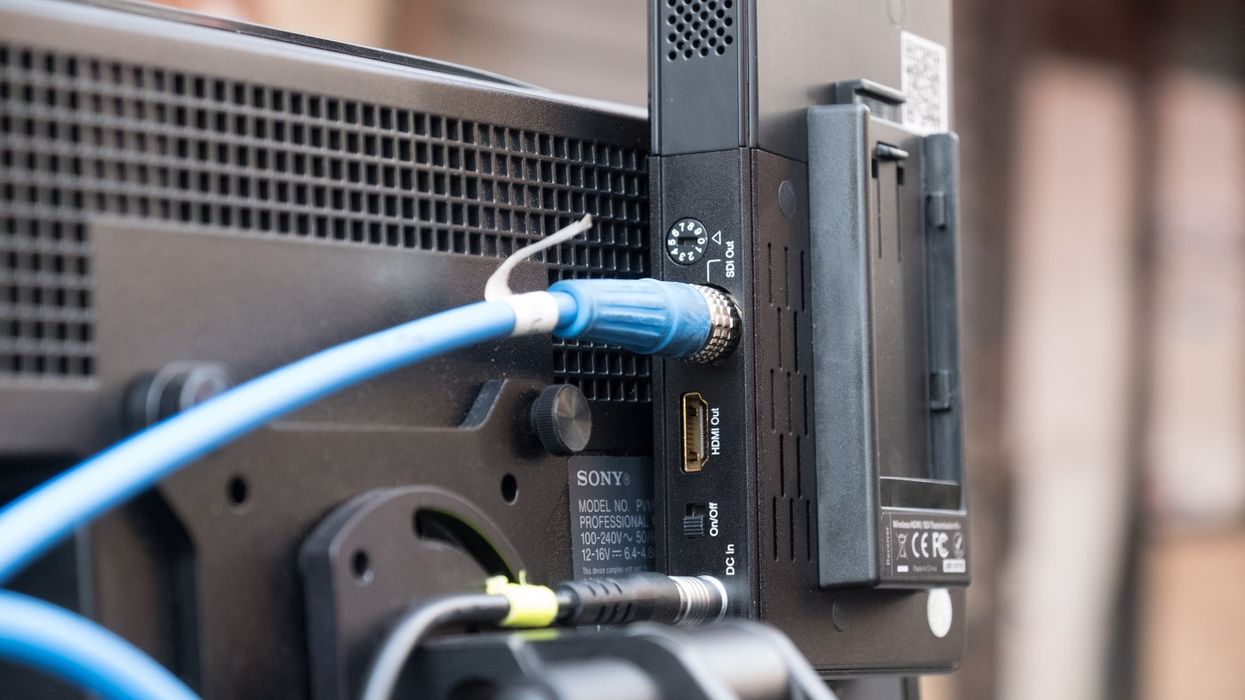FIELD TEST: Trigyn Apex Wireless Performs for Less
As film sets increasingly require wireless video transmission, Trigyn offers an indie friendly solution.

One day we blinked and wireless video became the norm. While big productions have long run wireless video across wide distances, and wireless setups have been a bastion of live production for a while, indie shoots held out, saving money by just running a cheap SDI cable to give the director or client a view of what was being shot.
However, it seems that wireless capability is now a requirement of independent shoots as well. It might be the growth of gimbals that require wireless for monitoring, or the preferences of users used to watching video wirelessly on their phone. Whatever the cause, in the last few years, it seems like every single set we visit down to the smallest productions is expected to have wireless for at least the main monitor, if not the director's monitor as well.

The players
The market leader in this field has long been Teradek and its corporate buddy Paralinx, both of which are frequently seen on sets large and small and provide reliable service at a fair price, but one that can feel hefty for an independent filmmaker. If you are only spending $3000 for your camera, spending another $3200 for the entry level Bolt 500 kit can be a stretch.
Lower cost options are coming onto the market—our own Oakley Anderson-Moore did a great review of the Freecast system that runs less than a $1000—but many of the lower cost options lack features that are required for regular production. The current Freecast is HDMI only, for instance, which rules out the more professional SDI cameras many pros use.

Enter the Trigyn Apex
One new entrant in the market is Trigyn Apex line, offering 1000 (5G1K) and 2000 foot (the 5G2k) systems designed specifically with filmmakers' needs in mind. The 1000 setup comes in around $1800 for an RX and a TX pair that offers all of the features filmmakers are looking for in a tidy bundle. It has HDMI and SDI connections and traditional 2-pin power that adapts out to a P-tap connector. Even better, it available with a native, no-cable Sony NP battery plate built right in, so if you are working with it on a camera that doesn't offer power output you can power it with the low cost, high capacity NP batteries that most filmmakers already own. We were curious if this lower-cost option could stand up to the rigors of indie production, so we decided to give them a look.
NOTE: Trigyn loaned us a 1k and 2k kit, along with V-mount Lanparte batteries, for this field test.

Signal radius
The entry level model starts with a 1000 foot radius, though those numbers should be treated as a general guideline no matter who the manufacturer is. Radio performs much differently in a wide open field than it does in an enclosed set, for instance. Shooting car-to-car in the country? 500 feet or more will be your range, and you'll get a connection up to 1000' though it might have some breakdown and go in and out. Shooting on a small stage and hoping to monitor from a spot a few stages away, with multiple walls in between? The signal might not make 200 feet. But that applies to a Teradek or a Trigyn alike.

Price
The Trigyn price point is very reasonable for what it offers. While saving money is important, it's only worth saving money if the equipment works—in this case, whether or not you are capable of delivering the video signal you need during a complicated production and ensure that the director or client can see the shot and give their feedback. In our tests, both in a lab environment and in the field, the Trigyn performed admirably. It never lost signal, even while working in complicated, difficult, radio heavy downtown New York locations, and it remained easy to work with throughout.

Encryption
The Trigyn features 128bit encryption, which is vital in this application and is a feature you should look out for with any video system you consider bringing to set. Why is encryption so important? Without it, anyone could buy a receiver and potentially discover and pair with your transmitter, letting them see what you are shooting.
You might not care if people see the raw footage from your music video shoot, but if you were working with a big name artist, they definitely would care. Or on a large and IP-conscious studio movie. Imagine showing up to be D-camera on the new Star Wars movie without an encrypted wireless link and having a fan in the studio parking lot see everything that was being shot. You'd never get hired by Disney, or maybe anyone, again.

One key to remember is that systems don't tend to play well with each other. While there are video streaming systems out there that broadcast normal old TV signals that can be received by any TV set with elephant ears, modern encrypted systems use a pair of a TX and an RX that work as a team, and a Trigyn transmitter won't pair with a Teradek receiver. Therefore, systems like the Trigyn are worth a serious look for users who tend to work with their own systems and don't end up as part of bigger productions.
If you are outfitting the AV department for a school and need wireless to capture sporting events, but are unlikely to ever need to bring in outside operators to work with your platform, this could potentially save you thousands while offering great functionality. If you are an up-and-coming DP and want to get your camera set up with wireless video for client review on small jobs, it's worth a look. However, If you are mid career and do a lot of multi-camera jobs with directors who show up with their own monitor, and they bought a Teradek Sidekick to receive Teradek signals, the Trigyn probably doesn't save you enough to be worth the sacrifice of compatibility. Of course, that Sidekick receiver the director owns cost around $2000, while an extra Trigyn receiver is only around $1400, meaning you might be able to squeeze in a second receiver and still come in around the price of the Bolt.

The 2K foot option
Trigyn also offers a more powerful, 2000 foot system that is worth consideration for longer range applications. It is available with a receiver antenna for more stable signal over long ranges. The price point is nearly $5000, which puts it beyond the reach for many independents.
The 2K foot system offers a functionality that is really more tailored towards broadcasters who want to stream back to a truck at the other side of a stadium. Film productions rarely have a director 2000 feet away who wants to monitor what's going on. However, if you do find yourself needing long range wireless, in our tests it also performed admirably, though it requires larger V-mount batteries to power the stronger signal. Trigyn loaned us a Lanparte battery setup that provided strong power for the 2000 ft kit, but be sure to factor the extra power needs into your estimate if deciding between the two systems.


Conclusion
The Trigyn units offer a great combination of price and performance that should give you a lot more flexibility on your next shoot. Potential drawbacks are that Trigyn is not the market leader, so ACs won't necessarily be familiar with it, and you'll frequently have to walk people through how to use it. However, it's so dead simple to get set up that that shouldn't be too much of a hurdle. If you are just dipping your toe into wireless video, and not looking to show up and be plug and play with the stadium near you for their live event systems, the Trigyn is worth a look.

The 1000ft is available as a TX/RX at the Trigyn site for $1899 including SDI cables, HDMI cables, a support arm, power cables and a case. The company is generously offering No Film School readers 10% off if you use the code 10NOFILMSCHOOL.
Tech Specs:
- 60fps 1080p signal
- 10bit video
- 4:2:2 chrome
- 2-pin battery
- Sony NP battery plate option
- Multi-cast to 4 receivers
- AES 128bit Encryption
- HDMI-SDI cross conversion
- Milled aluminum body
- TX: 9.6 oz weight. RX: 12.5 oz weight
- 3G-SDI and HDMI
- 7W power draw (approximate)
- Connect up to 1000', stable up to 500'











